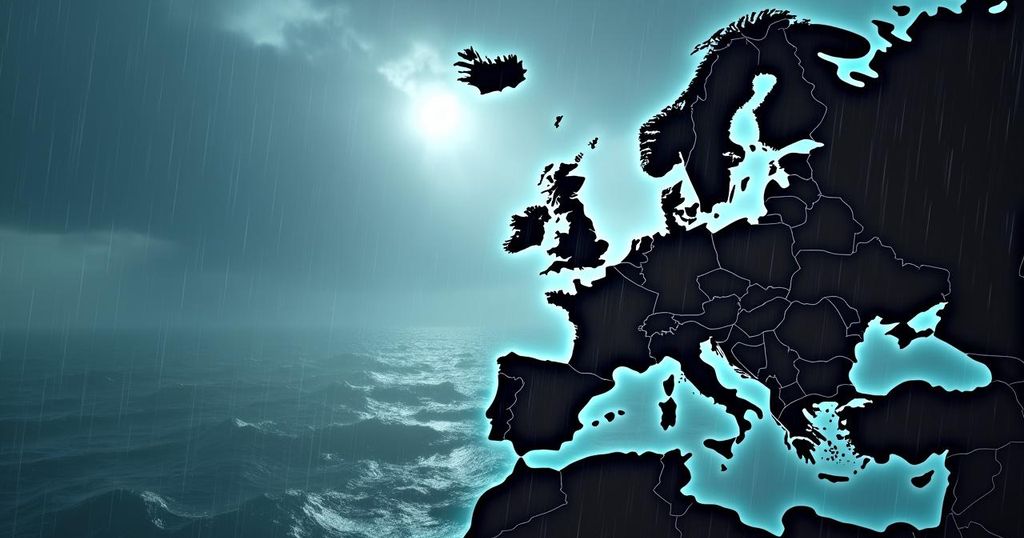Hurricane Kirk and Atlantic Weather: Impacts on Europe and Beyond

Hurricane Kirk is transitioning from a powerful storm to a downgraded status as it approaches Europe, with potential impacts on northern countries, while other hurricanes like Leslie and Milton are also in focus. Brazil is experiencing severe drought and low water levels in the Amazon River, marking an ongoing environmental crisis.
Hurricane Kirk is on a trajectory towards Europe, having peaked at a category 4 hurricane in the mid-Atlantic with maximum wind speeds reaching 145 mph. As it continues moving northeast, Kirk is anticipated to downgrade to a category 1 hurricane by Monday. In the following days, it will undergo extratropical transition, ultimately becoming an ex-hurricane upon its arrival on the European shores by Tuesday or Wednesday. Although there are variances in predictive models regarding the exact pathway of this extratropical cyclone, it is expected to traverse northern Europe, particularly affecting France, Belgium, the Netherlands, and northern Germany, where the strongest winds and most significant rainfall will occur. Portions of southern England may also experience heavy rainfall contingent upon whether the system veers slightly further north. In parallel, hurricane activity remains robust across the Atlantic, notably with Hurricane Leslie, which has recently been upgraded to a category 1 hurricane, boasting maximum sustained winds of 90 mph as of Sunday evening. However, forecasts suggest that Leslie will experience a rapid downgrade back to tropical storm status by Tuesday morning, with no anticipated land interaction. Additionally, a tropical disturbance located in the Gulf of Mexico has now been classified as Tropical Storm Milton. This marks the thirteenth tropical storm formation in the Atlantic this season. Milton is expected to intensify rapidly into a significant hurricane as it approaches Florida in the coming days, bringing potential risks of damaging winds, heavy precipitation, and life-threatening storm surges to certain areas of the western Florida coastline. This development follows the recent catastrophic impacts of Hurricane Helene, which resulted in substantial loss of life and widespread destruction across multiple states. Meanwhile, South America is grappling with an ongoing drought crisis, exacerbated by months of below-normal rainfall, which has led to extensive wildfires in Brazil. Water levels along the Amazon River have been steadily declining, currently reported at a 120-year low at the Port of Manus, a tributary site situated on the Negro River in northern Brazil, where water levels measured 12.66 meters compared to the historical average of 21 meters. This downward trend in water levels is expected to persist for several additional weeks.
The article discusses the recent movements and impending impacts of Hurricane Kirk as it approaches Europe, detailing its transition from a powerful category 4 hurricane to a downgraded status as it nears land. It also highlights other hurricane activities in the Atlantic, including Hurricane Leslie and Tropical Storm Milton, which are both under close observation for their potential effects on land. Additionally, the article sheds light on the drought conditions affecting Brazil, particularly the critical decrease in water levels in the Amazon River. Hurricanes are natural phenomena resulting from warm oceanic waters, and their paths and strengths can significantly impact affected regions. The discussion of these weather systems contextualizes the broader implications of climate conditions, particularly in light of recent severe weather events.
In summary, Hurricane Kirk is set to impact northern Europe, transitioning into an ex-hurricane while bringing strong winds and substantial rainfall to regions such as France and Germany. Concurrently, Hurricane Leslie approaches a downgrade, and Tropical Storm Milton is intensifying as it targets Florida. As these weather systems evolve, Brazil faces severe drought conditions impacting the Amazon River. These events underscore the critical need for ongoing monitoring and preparedness in the face of natural disasters caused by climatic variations.
Original Source: www.theguardian.com







